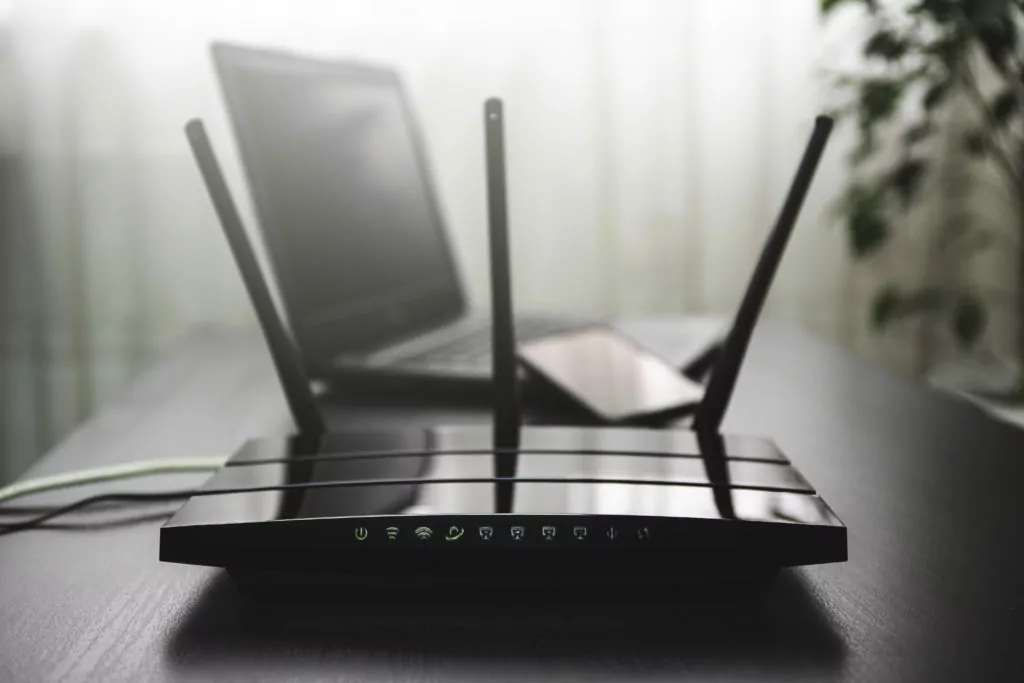Here’s what a hacker can do with a MAC address:
For the most part, a hacker can’t do a lot with your MAC address.
They can pretend to be you on the network, which is likely to be annoying more than dangerous.
But, if they get the MAC address to a router, they can spoof the network and potentially steal all kinds of information while you browse the internet.
So if you want to learn all about what a hacker can do with your MAC address, then you’re in the right place.
Keep reading!
How Can a MAC Address Be Used Against Your Wi-Fi Security?

Routers and networking equipment use several things to identify devices on a network, and one of those things is the MAC address.
This is a serial number that is encoded into every networking device when the device is manufactured.
That means every phone, computer, tablet, and more has a MAC address for the hardware that allows them to connect to your Wi-Fi.
Moreover, the MAC address for each device is truly unique in the world.
So, when you connect a bunch of devices to the Wi-Fi, the router needs to be able to distinguish each device to route traffic correctly.
One of the key identifiers that the router will use is the unique MAC address for each device.
How can a hacker make use of this?
If the hacker is able to obtain the MAC address for any device on the network, they can use something called MAC address spoofing.
With this technique, they can make your router think that their device is one of your devices.
When this happens, the router will allow the hacker’s device to get on the network because it has already given permission to the MAC address they are spoofing.
This is an advanced and effective way to get past Wi-Fi security.
A lot of networks can use something called MAC filtering.
This is an extra layer of security that will not let a new device join the Wi-Fi network unless the MAC address is specifically added to the router’s approved list.
The router acts like a bouncer at a club.
If the device’s name isn’t on the list, it can’t get on the network.
With MAC address spoofing, even this method of security is tricked.
The hacker can get on your network with impunity, and that can come with more consequences that will be discussed later.
Can the MAC Address Help a Hacker Disrupt a Network?

The whole purpose of MAC addresses is to distinguish devices on a network and prevent confusion.
If a hacker is spoofing the address of one of your devices, things get weird and complicated for the network.
Let’s say the hacker is spoofing your laptop. Just to keep the example simple, the hacker is using a tablet.
If the hacker’s tablet is connected while your laptop is off, this isn’t disruptive.
A hacker is on your network, which is never good, but things can get worse.
If your laptop and the hacker’s tablet try to connect at the same time, the router notices two of the same MAC address, and it gets confused.
In a best-case scenario, the router will send traffic to and from the wrong locations, and neither of you will be able to use the internet very well.
More likely, the duplicate MAC address will cause the router to kick one or both devices from the network.
Since a duplicate MAC address prevents the router from knowing where to send information, it will simplify the scenario by booting devices. With this, a hacker could prevent you from accessing your own internet.
It can get a little weirder.
Depending on the design of the router and the frequency with which the hacker attacks your network, the router can get confused enough to shut down altogether.
This doesn’t physically damage the router, but you can experience downtime on your Wi-Fi as the router tries to sort out the confusion of multiple MAC addresses.
How Does a Hacker Pick a Target?

There’s an underlying issue attached to this whole scenario, and you can get a feel for it by asking yourself a question.
Why does a hacker have your MAC address in the first place?
It takes effort on their part to obtain this information, and even when they have it, it isn’t the most lucrative thing to find.
The MAC address on your devices doesn’t allow hackers to steal information from you (typically).
They can’t extract money from the hack.
All they can really do is annoy you.
Yet, they still stole your MAC address. Why?
In almost every case, it will be a matter of opportunity.
You were targeted because you were an easy or tempting target, and that can come paired with additional problems.
If a hacker was able to obtain your MAC address, they may have stolen other information from you, and that gets a lot scarier.
If you think your MAC address has been hacked, you want to get some serious advice about how to protect yourself from hackers.
You will likely need to reset security protocols for all of your important internet accounts.
You need to resecure your Wi-Fi.
You want to take countermeasures because it’s hard to know just how much else a hacker was able to find about you or steal from you.
This type of hack points out to you that you are vulnerable.
What Does It Mean to Spoof a Device?

There’s one other threat of a hacker who stole your MAC address.
It’s less common, but it can happen, and it’s not good.
When they spoof your MAC address, they can use the internet while effectively pretending to be you.
One reason a hacker might do this is to avoid legal culpability if they choose to do nefarious things on the internet.
Illegal internet activity is serious, and authorities use a number of different methods to try to trace illicit activity to its source.
A hacker on your network won’t care much about avoiding any traces because any such trace will lead back to you.
The authorities could conceivably trace illegal activity back to your network, and if they checked the logs on your router, it would show that your laptop was the device sending these signals.
It’s a scary prospect.
It’s worth noting that this is not a common occurrence, but it has happened.
That means it could happen again, and it’s why you want to take steps to protect your Wi-Fi network.
How Do Fake Networks Work? (2 Ways)

So far, we have talked about what happens if a hacker has the MAC address of your personal device (like a computer or phone).
All of that is accurate, but there’s another MAC address that you want to protect.
What could a hacker do with the MAC address for your wireless router?
These implications are much deeper and scarier.
If the hacker has this MAC address, they can spoof your router instead of just a device on the network.
They can actually set up a fake network that will look exactly like your real one.
What this means is that you can unwittingly connect to a hacker’s network, and suddenly the potential for harm escalates.
If this sounds scary, it’s a somewhat common practice.
Now, the hacker is not likely to target your home Wi-Fi because then they can only attack you and the people who live with you.
Instead, it’s more common for hackers to do this with public wireless networks.
Airports, stadiums, schools, and other large-scale networks have been spoofed by hackers many times.
When they do this, they can convince large numbers of people in the area to unwittingly connect to the hacked network.
That allows them to cause serious trouble, primarily in two ways.
#1 Track Your Internet Usage

The first thing that can be done on a spoof network is tracking.
Everything you do on the internet is being sent through the hacker’s router.
They can use that to track all kinds of internet usage.
They can see the sites you visit, the types of accounts you use, and more.
They can collect this data and sell it to others who would use it to target you further.
They can also use this information to inform additional hacks or attacks, and the whole thing can spiral.
If you don’t like the idea of a hacker seeing everything you do on the internet, then always be sure you know what Wi-Fi you are using.
If you use a public network, assume that you could be watched the whole time.
It leads to safer behavior.
#2 Collect Data

The worst possibility is that a hacker can use this fake network to steal information from you.
This whole setup is often called a man-in-the-middle attack.
By getting you on their Wi-Fi, the hacker has established the means to see every single packet of information that you send while on the internet.
Think about the implications.
If you log into social media, the router can see it all.
If you do online banking, the router is copying that data.
We all do a lot on the internet these days, and you are potentially exposing very important information.
Before panic sets in, there is a ray of hope.
Even with this type of attack, it’s very difficult to steal some kinds of information, and that has to do with encryption.
If you look at the full name of any website, it pretty much always starts with “HTTP.”
Your browser might truncate this part since it’s always there, but when you look up the formal name of a website, it’s there.
If you look a little closer, you’ll see that some sites start with HTTP while others start with HTTPS.
This is one of the most important distinctions on the internet.
The “s” that is on some sites denotes a layer of security.
That s means that the site uses encrypted communication.
So, if you connect to an HTTPS site while on a hacker’s network, every packet you send and receive will be encrypted.
Even though they get to see the packets, what they get is an encoded message that they can’t decipher.
This protects your bank account number and passwords to accounts and a lot of sensitive information.
So, here’s the most important lesson in everything you just read.
If you are on a public network, only connect to HTTPS sites.
Save HTTP browsing for when you are safe at home.


